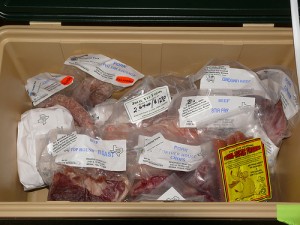Meat Packaging Techniques
 Meat packaging is accomplished by wrapping the meat items with the help of defensive materials and is necessary to save the meat from atmospheric hazards. In the past period, the materials used were natural objects like leaves, however as time went by innovative progresses were found out causing meat packaging materials such as synthetic as well as paper films.
Meat packaging is accomplished by wrapping the meat items with the help of defensive materials and is necessary to save the meat from atmospheric hazards. In the past period, the materials used were natural objects like leaves, however as time went by innovative progresses were found out causing meat packaging materials such as synthetic as well as paper films.
Yet another essential characteristic for the meat packaging material is, it is required to be water-vapor-proof, the reason being quite a lot of water as well as characteristics are given out from the sausages, cooked ham and fresh meat, when they stay unpacked. Packaging saves the meat from decaying by dust, bacteria, parasitic organisms and poisonous objects, from developing odd aroma, color and flavor and from losing or addition of water content. Still this is secondary decomposition. There are bacteria already present within the meat. And to check their further development or to devastate them totally, certain additive procedures are required to be combined together with packaging, for example refrigeration for stopping or decelerating the proliferation of the pathogens and sterilization or heating for eliminating the bacteria.
Generally, the inside meat packaging is accomplished where the material comes in immediate contact with the meat. And many times outer packaging is also done in form of packs made of cardboard or some particular materials. The inside packaging is implemented by using various kinds of films, which can be transparent or opaque, gas-permeable or gas-proof or flexible or hard to semi-rigid. All these sorts accomplish some specific tasks, which consist of attractive presentation as well along with protection of meat.
Ideal packaging material should be firm, yet stretchy; it should be gas-proof, heat-resistant, clean, light in weight, odorless, with sealing capability and plus must be low-cost.
Amongst these characteristics, non-permeability to gases is the most important feature. The uncovered meat, when comes in contact with O2 in atmosphere, amends its coloring to green or grey. Oxygen causes turning it stale and awful-smelling. Hence the packaging material should be the least oxygen-permeable. And when this is done together with vacuum packaging, the protection to the food is the best, as, it makes sure the distracton of O2 from inside and stopping outside O2 from going inside.
This sort of packing has an exception as well. In the eateries selling fresh meat products the oxygen-permeable packaging material is made use of, which offers the meat item, an interesting fresh red coloration.
Another vital characteristic for the meat packaging material is, it needs to be water-vapor-proof, because plenty of water and qualities are given out from the fresh meat, cooked ham or sausages, when they are left unpackaged.
Light too causes bad changes in unpackaged meat objects in form of rancidity, change of color and oxidation. Although transparent packaging material is alluring, because the object is visible through it, it imparts no security from light. So meat items packed in such sort of packages need to be placed in dark. Aluminum laminated foils are the most appropriate for light-sensitive substances.
Conventionally, synthetic plastic materials are made use of for meat packaging. The foils for packaging are divided into single-layer and multi-layer. Single-layer is normally made use of for packaging of meat blocks and meat cuts and smaller segments of meat. Their vital utilization is storing in freezer. While storing the meat blocks in freezer, the single-layer foil is wrapped compactly over the block so as to check vapor-loss, formation of ice and refrigerator burn, which takes place at the non-contacted segment of the meat. Multi-layer film performs two essential jobs, by the virtue of its outer and middle coating preventing oxygen from getting in and the inside layer stopping loss of water in form of vapor.
Lots of other packaging sorts and procedures also are applied, for example heat treatment, skin packaging, form-shrink packaging and many others, while accomplishing meat packaging.
